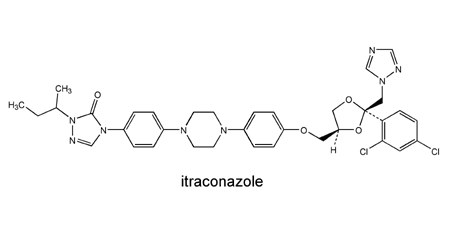Manufacturer’s Prescribing Information
Trade & Generic Names & General Features
Itraconazole is triazole antifungal agent. As with other triazoles, it has five-membered ring structures containing three nitrogen atoms [2092]. It is available in oral capsule form (since 1992), oral solution in cyclodextrin (since 1997) and intravenous formulation in hydroxy-propyl-beta-cyclodextrin (since 1999). In its capsule and oral solution form, itraconazole is marketed as Sporanox™ by Janssen Pharmaceuticals ((E):http://us.janssen.com/(E):). The intravenous formulation is marketed by Ortho Biotech.
Itraconazole is a highly lipophilic compound. While it achieves high concentrations in fatty tissues and purulent exudates, its penetration into aqueous fluids remains very limited. Gastric acidity and food influence the absorption of oral formulation [156].
Absorption of itraconazole oral capsule is variable and unpredictable. Oral solution of itraconazole is superior to the oral capsule in terms of absorption and bioavailability.The oral solution has 30% better bioavailability than the capsules and achieves higher serum concentrations. Moreover, it probably has a topical antifungal effect which is significant particularly in treatment of oropharyngeal candidiasis. THe oral solution is thus generally preferred, although it is less convenient than the oral capsule. The intravenous formulation, on the other hand, achieves adequate blood levels more rapidly and its bioavailability is predictable and invariable compared to the oral capsule [289, 388, 2293, 2495].

Mechanism(s) of Action
As with all azole antifungal agents, itraconazole works principally by inhibition of cytochrome P450 14a-demethylase (P45014DM). This enzyme is in the sterol biosynthesis pathway that leads from lanosterol to ergosterol [2092].
Itraconazole is active in general against various types of fungi, including yeasts, moulds, and dimorphic fungi. Among these are, Candida spp., Cryptococcus neoformans, Aspergillus spp., Pseudallescheria boydii, Sporothrix schenckii, Histoplasma capsulatum, Blastomyces dermatitidis, Coccidioides immitis, Paracoccidioides brasiliensis, Penicillium marneffei and dermatophytes [2092].
Resistance to itraconazole is detectable among the types of fungi noted above as well as others. Its activity against some (but not all!) fluconazole-resistant C. krusei and C. glabrata isolates is noteworthy. However, cross-resistance among azoles is not uncommon and a subset of fluconazole-resistant isolates generate high itraconazole MICs as well [1643]. Aspergillus fumigatus isolates that are resistant to itraconazole in vivo and generate high MICs in vitro have already been identified [578]. Activity of itraconazole is limited against Fusarium spp. [119] and zygomycetes group of fungi [1494].
For itraconazole MICs obtained for various types of fungi, see susceptibility patterns and the N/A(L):susceptibility database.
Usual Doses
Itraconazole is used at doses of 100-400 mg daily by oral route. At 400 mg/day, better levels are achieved with b.i.d. dosing [389, 548, 634, 985]. Intravenous itraconazole is administered at a dose of 200 mg b.i.d. for two days, followed by 200 mg/day.
Side-Effects
Itraconazole may rarely cause mild side effects. These are in general similar to those of fluconazole. Hypertension, hypokalemia, oedema, headache and alterations in mental status are seldomly observed [577]. Hepatotoxicity is rare [2092].
Routes
Itraconazole has intravenous and oral (capsule and solution) formulations.
Current Status
Itraconazole is used in treatment of infections due to most yeasts, as well as moulds. Its major advantages over fluconazole are its activity particularly against most Aspergillus isolates and a subset of fluconazole-resistant Candida strains. The inconsistent bioavailability of the capsule limits the use of that form, and the oral solution is preferred. The intravenous formulation provides an intriguing new ability to deliver itraconazole effectively, but the full clinical relevance of this is not yet known.
